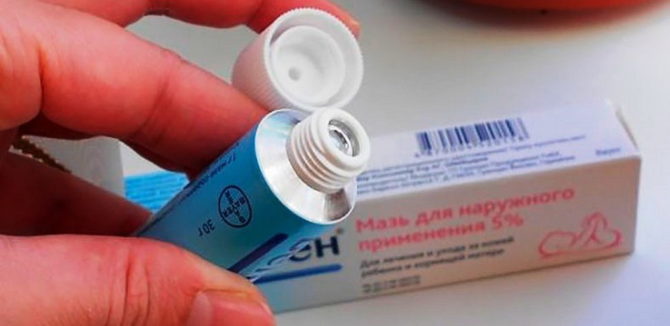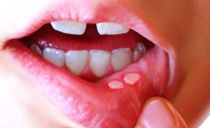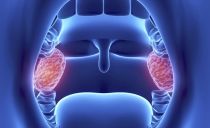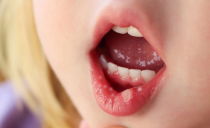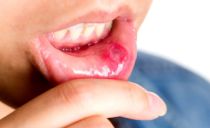The best ointments for the treatment of stomatitis in the mouth in children and adults
The choice of ointment for stomatitis in the mouth is carried out taking into account the cause and etiology of the disease, as well as the age of the patient: most often this disease affects children and adults with reduced immunity.
If the pathology is caused by an allergy, then liniment, balms and creams will not help in the fight against the disease. In this case, a complex treatment of the body is required, and not just local treatment of ulcers. Antifungal agents are effective against a fungal pathogen, and antibacterial agents against bacteria.
Content
Ointment for stomatitis: classification, names of the best drugs
Everything topical agents for stomatitis in the oral cavity can be divided into antibacterial, antifungal, antiviral, universal and painkillersrequired for local anesthesia. Therefore, before starting their use, you need to determine the type of disease. If you treat fungal dental sores in the oral cavity with an antiviral ointment, the disease will continue to progress, which is fraught with the development of complications: tonsillitis or pharyngitis.
The type of disease is determined by the doctor based on a visual examination of the patient. Laboratory studies are carried out very rarely and only for the purpose of differential diagnosis.
Anesthetics
Painkillers do not affect fungi, bacteria and viruses. They are prescribed for stomatitis only to stop pain and only if the disease is caused by an allergy. Since many antibacterial and anti-inflammatory drugs have their own anesthetic effect, stomatitis therapy including their administration can be carried out without the use of pain medication.
Calgel
Gel Kalgel can not be called a purely anesthetic, but usually it is used specifically for the relief of pain. It contains 2 active substances: cetylpyridinium chloride, which has antiseptic properties, and anesthetizing lidocaine.
This drug can be used to treat large aphthae and small sores on the oral mucosa in both adults and children.
Holisal vs aft
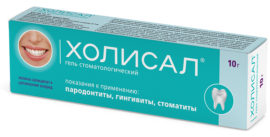 In addition to a strong anesthetic effect, Holisal has an antipyretic, antipruritic and anti-inflammatory effect. It can be used for all types of dental disease, even when treating children under one year old and pregnant women. The drug is quick-acting, applied to ulcers no more than 3 times a day.
In addition to a strong anesthetic effect, Holisal has an antipyretic, antipruritic and anti-inflammatory effect. It can be used for all types of dental disease, even when treating children under one year old and pregnant women. The drug is quick-acting, applied to ulcers no more than 3 times a day.
Solcoseryl
Solcoseryl is available in the form of a gel and ointment. Saliva practically does not affect its absorption, so it is indicated for various diseases of the oral cavity. This effect is achieved due to the unique composition of the drug: it contains elements of the blood of calves.
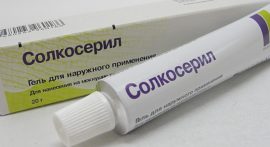 Positive effects after using Solcoseryl:
Positive effects after using Solcoseryl:
- blood supply in the oral cavity improves;
- damaged tissues are tightened;
- the structure of the mucosa is restored;
- collagen synthesis is stimulated.
After lubricating the aphids with Solcoseryl, a person can eat and drink, since the product is insensitive to saliva and fluid. But before applying the drug, it is recommended to clean the affected areas of the oral mucosa from pus and dead particles for better absorption of the drug.
Lidochlor
Lidochlor is used for surface treatment of ulcers.It has few contraindications, but is used with caution to treat pregnant and young children.
The purpose of Lidochlor is especially relevant if, in addition to dental ulcers, the patient has tartar. Purely for local anesthesia, this drug can be applied only 1 time in 2 days.
Kamistad
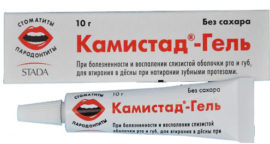 The active ingredients of this medicine are lidocaine and chamomile extract. The gel not only anesthetizes well, but also promotes the healing of the oral mucosa, relieves inflammation and destroys pathogenic bacteria. The drug is not used in the treatment of children under 3 years old and pregnant women.
The active ingredients of this medicine are lidocaine and chamomile extract. The gel not only anesthetizes well, but also promotes the healing of the oral mucosa, relieves inflammation and destroys pathogenic bacteria. The drug is not used in the treatment of children under 3 years old and pregnant women.
Instillagel
Instillagel is an effective analgesic and healing agent with chlorhexidine. This drug kills yeast, dermatophytes, gram-negative and gram-positive microorganisms. Anesthetic effect is achieved 5-10 minutes after applying the therapeutic gel.
Antibacterial agents
Antibacterial therapy is indicated in case of detection of concomitant infections (not only in the oral cavity), ulcers with purulent contents, bacterial or ulcerative necrotic forms of the disease. Most often, with inflammation of the mucous membrane of the oral cavity, the following ointments and gels with an antibacterial effect are prescribed:
- Lincomycin.
- Dent's metrogil synthesized on metronidosole. After using this drug, it is forbidden to drink ordinary water and any other liquid.
- Tetracycline ointment.
- Gentamicin.
- Kanamycin.
The use of an antibacterial ointment against stomatitis is permissible only for medical reasons.
Tetracycline ointment
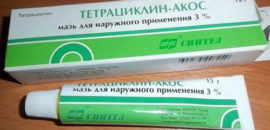 The active substance of the drug is tetracycline. The tool has a wide antibacterial spectrum of action, is contraindicated for mycoses and leukopenia.
The active substance of the drug is tetracycline. The tool has a wide antibacterial spectrum of action, is contraindicated for mycoses and leukopenia.
The use of tetracycline ointment is undesirable for the treatment of children under 8 years of age. The medicine is dispensed without a doctor’s prescription, but it should be remembered that it refers to antibiotics, and therefore should be used with extreme caution.
Lincomycin
Lincomycin ointment for treating the oral mucosa is used in diseases that are caused by the activity of aerobic and anaerobic gram-positive bacteria. The medicine belongs to the group of lincosamides.
Lincomycin has the property of being deposited (accumulated) in the tooth and bone tissue, due to which the drug not only eliminates all sores on the oral mucosa, but also helps to avoid the attachment of a secondary infection.
Gentamicin
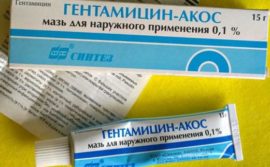 Gentamicin can not be taken for too long, as this can cause pathogens to get used to it. The tool helps in the treatment of diseases caused by gram-positive and gram-negative aerobic microorganisms. Gentomycin ointment can not be used to treat stomatitis caused by anaerobic bacteria, viruses or fungi.
Gentamicin can not be taken for too long, as this can cause pathogens to get used to it. The tool helps in the treatment of diseases caused by gram-positive and gram-negative aerobic microorganisms. Gentomycin ointment can not be used to treat stomatitis caused by anaerobic bacteria, viruses or fungi.
The therapeutic effect of the drug lasts for 8-12 hours, so it is recommended to apply it no more than 2 times a day. The medicine can not be used in the treatment of young children and pregnant women. In addition, it is contraindicated to use gentamicin in combination with aminoglycoside-based agents for the treatment of ulcerative surfaces.
Anti-mycosis drugs
Treatment of candidal stomatitis involves the use of special antifungal agents. These include:
- Clotrimazole, instantly inhibiting the growth of fungus in the oral cavity, provided that it is applied at least 3 times a day.
- Candide, which can be called an analogue of clotrimazole.
- Nystatin ointment, used with extreme caution due to the large number of side effects.
- And also Pimafucin, Miconazole, Dactarin, Levorin.
Clotrimazole
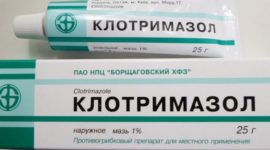 Clotrimazole, prescribed for stomatitis, has an antimycotic effect and has the greatest activity in relation to:
Clotrimazole, prescribed for stomatitis, has an antimycotic effect and has the greatest activity in relation to:
- yeast-like mushrooms;
- dimorphic mushrooms;
- dermatophytes.
Clotrimazole blocks the synthesis of nucleic acids, ergosterol and proteins, which violates the structure of the cell walls of the fungus, and pathogenic microorganisms die.
Pimafucin
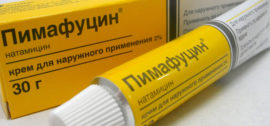 Pimafucin, a healing cream for stomatitis, contains natamycin, a broad-spectrum antibacterial drug that destroys the cell membrane.
Pimafucin, a healing cream for stomatitis, contains natamycin, a broad-spectrum antibacterial drug that destroys the cell membrane.
The medication is effective against most fungi, with the exception of dermatophytes. The duration of its use is determined individually, but after the symptoms have been eliminated, the affected areas should be lubricated with another 2-3 days.
Antiviral drugs
Stomatitis is a body reaction that can be triggered by absolutely any virus. Usually viral stomatitis develops against the background of other diseases (measles, herpes, flu, chickenpox) and is treated in combination with the underlying disease. For these purposes, the following ointments and creams are used:
- Oxolinic ointment, which fights against influenza and herpes viruses.
- Zovirax is an effective remedy for herpetic eruptions.
- Acyclovir is a wound healing drug suitable for the treatment of primary and recurrent herpetic stomatitis.
- Metrogil dent.
- Viferon.
- Methyluracil ointment.
Oxolinic Ointment
The active substance of the drug is oxolin. This medicine has practically no contraindications, the exception is individual intolerance to the components of the drug. Thereby Oxolinic ointment is often used to treat stomatitis during pregnancy and lactation, as well as in childhood. The drug is applied to sores 3-4 times a day until complete recovery.
Oxolin possesses antiviral properties against influenza viruses, herpes zoster and herpes. Available in the form of an ointment containing 0.3% and 0.25% of the active substance. But for the treatment of inflamed oral mucosa, only a remedy with 0.25% of the active substance is used.
Viferon
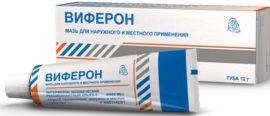 Viferon - a means of increasing immunity. Due to the absolute harmlessness, the ointment can be used in the treatment of adults and children without restrictions. The composition of the drug includes interferon α-2, which stops the process of HPV synthesis and protects the body from secondary infection.
Viferon - a means of increasing immunity. Due to the absolute harmlessness, the ointment can be used in the treatment of adults and children without restrictions. The composition of the drug includes interferon α-2, which stops the process of HPV synthesis and protects the body from secondary infection.
Ointment is often used for stomatitis in children. Its use is most productive at the very beginning of the disease, when vesicles have not yet formed, but itching and burning are already present.
Methyluracil
Methyluracil is a substance that improves trophic tissue and increases their regenerative properties. The drug stimulates nucleic acid metabolism in the oral mucosa, due to which aphthae quickly heal. Methyluracil is contraindicated in the presence of malignant and benign tumor formations in the body.
The best drugs for adults
The use of a particular ointment for stomatitis in adults is due to the type of pathogen that caused the disease, concomitant diseases and the severity of symptoms. Usually the same drugs are used as for the treatment of children, but at a higher dosage. In addition, for the treatment of stomatitis in an adult, the following are used:
- Nystatin for fungal stomatitis.
- Zovirax.
- Tetracycline ointment.
- Kamistad.
- Lidochlor.
- Gentamicin.
Usually, the inflamed parts of the oral mucosa are smeared with the listed drugs until they are completely cured, but sometimes the therapy continues after the aphthous healing. The exact course of treatment is determined by the doctor based on the differential laboratory diagnosis.
The best remedies for stomatitis in children
Gels with a mild effect are used to treat stomatitis in children. Specifically, children's remedies for inflammation of the oral mucosa do not exist, doctors prescribe adult drugs to children based on their body weight, age and state of health.
For complete healing and regeneration of the oral mucosa with stomatitis in children, the following ointments are used:
- Acyclovir (5%), used to treat herpetic stomatitis.
- Bonaphton (0.25%) is a healing agent that is used in the treatment of herpetic stomatitis. When used in small children, small rashes are possible.
- Viferon is an ointment prescribed for stomatitis in children older than a year.
- Oxolinic or Tebrofen ointment.
- Vinylinum in the form of a balm or ointment.
- Bonaphton is a cream with the active substance bromonaphthoquine.
- Myconase is an antifungal ointment for stomatitis that children like because of its sweetish taste.
- Actovegin (5%).
- Holisal. For the treatment of ulcers in the oral cavity in babies, a pea of Holisal gel is enough.
A medicine for stomatitis (including for pain relief) should be prescribed by your doctorOtherwise, there is a risk of complications due to improperly selected liniment or solution.

